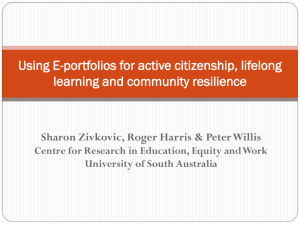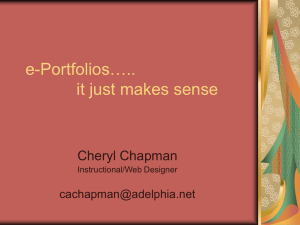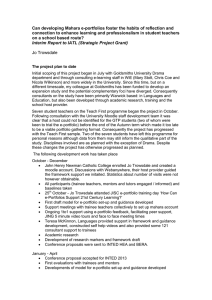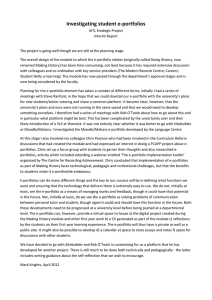Motion to investigate Electronic Portfolios for the Faculty Tenure and... 03/25/09 Purpose: This motion recommends that the Provost appoints a campus...
advertisement
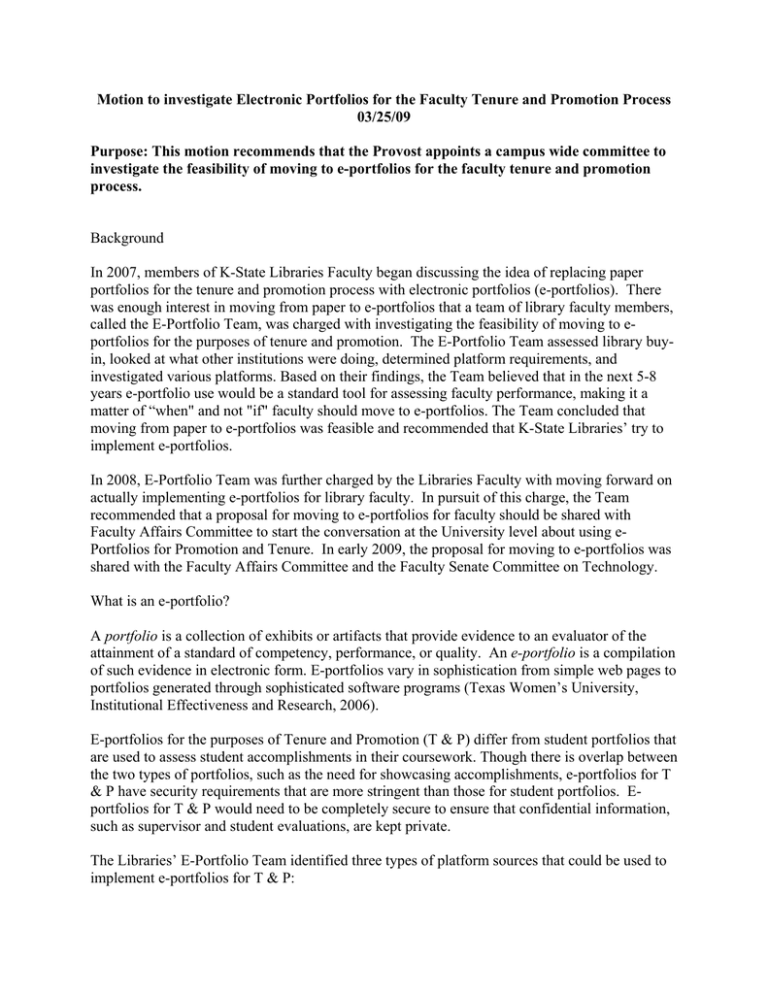
Motion to investigate Electronic Portfolios for the Faculty Tenure and Promotion Process 03/25/09 Purpose: This motion recommends that the Provost appoints a campus wide committee to investigate the feasibility of moving to e-portfolios for the faculty tenure and promotion process. Background In 2007, members of K-State Libraries Faculty began discussing the idea of replacing paper portfolios for the tenure and promotion process with electronic portfolios (e-portfolios). There was enough interest in moving from paper to e-portfolios that a team of library faculty members, called the E-Portfolio Team, was charged with investigating the feasibility of moving to eportfolios for the purposes of tenure and promotion. The E-Portfolio Team assessed library buyin, looked at what other institutions were doing, determined platform requirements, and investigated various platforms. Based on their findings, the Team believed that in the next 5-8 years e-portfolio use would be a standard tool for assessing faculty performance, making it a matter of “when" and not "if" faculty should move to e-portfolios. The Team concluded that moving from paper to e-portfolios was feasible and recommended that K-State Libraries’ try to implement e-portfolios. In 2008, E-Portfolio Team was further charged by the Libraries Faculty with moving forward on actually implementing e-portfolios for library faculty. In pursuit of this charge, the Team recommended that a proposal for moving to e-portfolios for faculty should be shared with Faculty Affairs Committee to start the conversation at the University level about using ePortfolios for Promotion and Tenure. In early 2009, the proposal for moving to e-portfolios was shared with the Faculty Affairs Committee and the Faculty Senate Committee on Technology. What is an e-portfolio? A portfolio is a collection of exhibits or artifacts that provide evidence to an evaluator of the attainment of a standard of competency, performance, or quality. An e-portfolio is a compilation of such evidence in electronic form. E-portfolios vary in sophistication from simple web pages to portfolios generated through sophisticated software programs (Texas Women’s University, Institutional Effectiveness and Research, 2006). E-portfolios for the purposes of Tenure and Promotion (T & P) differ from student portfolios that are used to assess student accomplishments in their coursework. Though there is overlap between the two types of portfolios, such as the need for showcasing accomplishments, e-portfolios for T & P have security requirements that are more stringent than those for student portfolios. Eportfolios for T & P would need to be completely secure to ensure that confidential information, such as supervisor and student evaluations, are kept private. The Libraries’ E-Portfolio Team identified three types of platform sources that could be used to implement e-portfolios for T & P: 1. Homegrown (e.g. K-State Online) 2. Commercial (e.g. pay to outsource the platform. Many e-portfolio companies currently exist) 3. Open Source (e.g. implementing an open source program such as MyMAPP from the University of Nebraska – Omaha). Why E-Portfolios? E-portfolios have many benefits over traditional, paper based portfolios. The following reasons have been identified as why moving to e-portfolios would be desirable: • • • • • • • • • • Moving to e-portfolios supports Theme 6 of the University’s Strategic Plan: Provide Access to Technology for Information Exchange and for the Creation of New Knowledge. Eportfolios are an educational technology that would support the teaching, learning, research, technology transfer, public service and other outreach efforts of the faculty. Many items included in a T&P portfolio are already in electronic format. Converting them to paper loses interactive qualities, multimedia aspects, and flexibility. For some portfolio items that originate in print, converting them to electronic is often less hassle than formatting something from electronic to print. Much more is lost converting to print than converting from print. Moving to online would decrease that problem significantly. E-portfolios support Theme 9 of the University’s Strategic Plan: Contribute to the State’s Economic Development and Environmental Health by promoting a low-impact, sustainable, and environmentally friendly method for developing faculty portfolios. An e-portfolio is more dynamic than a print portfolio, easily allowing the integration of audio and video displays. Web-based format would make the portfolio portable and easy to distribute for review. They are flexible and adaptable because they provide the ability to present substantial evidence of teaching and other activities (e.g. by including multimedia, links to the full-text of research articles, etc.), and are increasingly being used in higher education. Nonlinearity can be a major strength of e-portfolios and enables links of all sorts. Portfolio creators are no longer locked into linear organization. The sheer volume of data available on the web, or capable of being stored on the web, dwarfs most other media. Electronic course ratings from students could be imported into faculty e-portfolios. Anticipated Impact Moving to e-portfolios would have an impact on faculty members building e-portfolios as part of their T & P process, faculty members evaluating T & P candidates’ e-portfolio contents, and university staff responsible for providing the platform’s technological infrastructure and support. 2 Conclusions As far as we know, there are currently no plans at K-State to implement e-portfolios for faculty. The e-Portfolio Team followed many leads and determined that any talk on campus about eportfolios has been about student e-portfolios, not faculty. Until recently, primary use of eportfolios in higher education has been for the purposes of assessing student work. However, many universities are moving to e-portfolios for the tenure and promotion process (e.g The California State University, University of Illinois at Urbana-Champaign, University of Nebraska – Omaha, University of Wisconsin – LaCrosse). In cases where e-prtfolios were being used for the tenure and promotion process, we found that implementation of e-Portfolios was an institution-wide practice originating from the upper levels of the university (e.g. Council of Deans, Provost’s Office). To be implemented successfully, e-portfolios need to have campuswide buy-in and directive from the campus administration. Cited: Texas Women’s University, Institutional Effectiveness and Research. (2006). Portfolios and Eportfolios: Definitions and Types. Available online at http://www.twu.edu/iep/E-portfoliosTerminologyDefinitions.pdf. Examples of Institutions Implementing E-Portfolios: The California State University http://teachingcommons.cdl.edu/eportfolio/about/index.html University of Illinois at Urbana-Champaign http://www.provost.uiuc.edu/committees/eportaleportfolio.html University of Nebraska – Omaha http://mymapp.unomaha.edu/ University of Wisconsin – LaCrosse http://www.uwlax.edu/PROVOST/pvchome/eportfolios.htm 3
